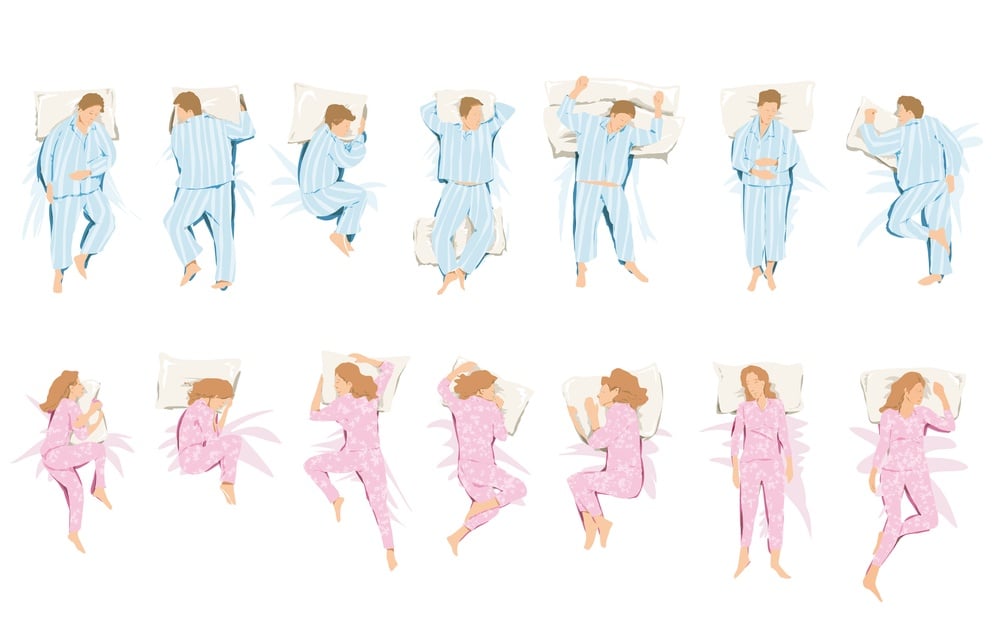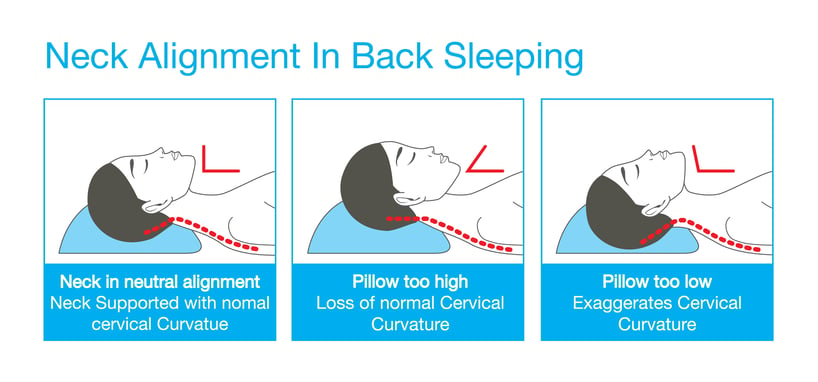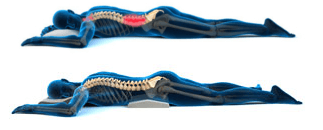How Sleep Position Affects Your Spine
March 2nd, 2017 | 5 min. read

When you think of poor posture leading to orthopedic issues like lower back pain or neck pain, standing posture or sitting position probably come to mind. But there’s a third type of posture you may be forgetting, and it affects your health just as much as standing and sitting — it’s your sleeping position.
Your body’s posture during sleep can have a negative effect on your spinal column — and other body parts, too
Minus a few tosses and turns in the night, the posture we hold during sleep is sustained for several hours at a time. If something in the body is crooked, twisted, pinned under another body part, or held at a strange angle, it can stay that way for far, far longer than it would when you’re awake.
As you probably know from experience, the result of an awkward sleeping posture can be painful the next day, ranging from the pins and needles of an 'asleep' limb to the torture of a middle-of-the-night leg cramp.
And then there’s your spine — your back and neck.
Sleep Position and Spine Problems
If you’re waking up in pain that you don’t feel during the day, then your sleep position is likely playing a role.
Where sleep posture plays a role in back pain is the neutral spine. If you’re not positioned in a way that keeps your spine aligned and relaxed, you may be putting excess weight or strain on different parts of the back.

If you have neck pain, stiffness, or soreness when you wake up in the morning, consider:
- Sleep posture. Sleeping on your stomach with your head twisted to one side is a recipe for neck strain. But sleeping in any position can be a problem if your neck isn’t sufficiently supported.
- Pillow choice. If your pillow is too high or too low, too firm or too soft, your head will bend away from the neutral spine position. Finding the right pillow can be difficult. Some people prefer memory foam because it molds to the head and neck, providing support where you need it most.
- Weak or tight muscles. If you don’t stretch often or if you keep your shoulders and head in a fixed, unnatural position during the day, you may may be bringing that stress to bed at night. Stretching, strengthening, and massage may help you to re-balance your body and loosen up in the neck and shoulders. It’s difficult to achieve a neutral spine in sleep if you can’t achieve it when you’re awake.
- Other issues. Neck pain can also be caused by other orthopedic conditions like a muscle strain, osteoarthritis of the cervical spine, or a slipped disc. Seeing an orthopedic physician can help to determine whether you have another issue that may be contributing to a pain flare-up when you sleep.
When you are asleep, your body is at rest. Your spine and other joints are not bearing any weight. This should not cause pain. If you have back pain when you sleep (most commonly, lower back pain), chances are it’s caused by something other than your sleep posture. You may have an underlying issue like osteoarthritis of the spine, a slipped or herniated disc, sciatica,
For most people, though, daytime posture and lifestyle is a huge contributor. Back strains from carrying heavy objects, for example, can strain muscles and ligaments. Holding an awkward body position when driving, sitting at a desk, or standing and walking can also lead to muscle tension or weakness on one side of the body.
As with neck pain, it’s important to sleep in an optimal position — but also to choose the right mattress and the right pillow, and to use extra pillows or bolsters if necessary.
Click the image below to request an appointment today!
What Sleep Position is Best for Spine Health?
The National Sleep Foundation has ranked sleep positions based on what’s best for your overall health and wellness. This ranking takes into account both your orthopedic fitness and your general health (recognizing that some sleep positions are more likely than others to contribute to concerns like sleep apnea or gastrointestinal issues).
Their ranking is consistent with what orthopedists recommend. When you’re sleeping, you should strive to keep your spine as neutral as possible — including your head position. Your legs should be elongated if possible, but not overly straight. Keep a natural bend in the knee.
By keeping the body position neutral and relaxed like this, your spine will stay in a position similar to its optimal standing posture: chin up, shoulders low, back straight (not arched), knees relaxed, hips aligned with the shoulders.
A neutral spine keeps your muscles long and loose, not flexed, which reduces the risk of soreness or tightness anywhere in the body. For example, by keeping your legs straight, not bent at ninety degree angles, you eliminate the risk of your knee ligaments becoming tight and stiff in a bent position.
Neutral spine posture is also symmetrical, which keeps your body in balance; the muscles on one side of your body won’t be working harder than the other.
Keeping this in mind, the best sleep positions for back and neck health are, in order:
- Flat on your back. Lying flat is the nearest approximation to standing in a relaxed posture with your head, neck, and spine aligned. Lying flat also evenly distributes your weight across your body. Be sure to support your head with a good pillow. Some people with pronounced arches in their lower backs may also need to place an additional pillow or yoga bolster under the knees to relieve strain and tension pulling on the lower back muscles. A small lumbar pillow may also be helpful. Some people also benefit from keeping their feet slightly raised.

- Lying on your side. Though sleeping on your back is best, it’s not an easy position for everyone. If you find you can’t convert to sleeping on your back, the second best thing is to be a side sleeper — but elongate your legs to maintain a neutral spine. Note that one of the potential side effects of this position is a sore neck. You can reduce your risk of neck pain by choosing the right pillow, one that supports your neck so it remains more or less straight, rather than bent toward the mattress. If you can, try to alternate sides, too.

- Fetal position. This is the most popular sleep position by a landslide, and for good reason — it’s the first sleep position any of us knew, so it feels right. However, curling up too tightly can lead to stiffness and soreness, especially as you get older and your muscles, ligaments, and tendons aren’t as elastic as they used to be. A tight fetal position can also be rough on people with arthritis in the knees, hips, and back. If you must sleep this way, focus on loosening your body position and untucking your chin. Don’t curl your wrists — wearing a wrist splint can help with this — and use a pillow between your legs if you have hip pain.
- Sleeping on your stomach is by far the worst position for your health. It’s particularly bad for your spine if you’re turning your head to one side to breath. Keeping the neck in a twisted position all night can lead to neck pain from muscle strains. A twisted head and neck can also lead to soreness in the shoulders and upper back. Stomach sleeping puts pressure on your knee joints, which are pointed downward into the mattress, and holds your feet in an unnatural position. It’s not uncommon for stomach sleepers to wake up with aches and pains, tingling nerves, and numbness. If you are a devoted stomach sleeper, try to keep your head straight to relieve pressure on your neck. Placing a firm pillow under your forehead can create enough space for you to breathe when your head is facing down. A firm pillow under the abdomen can also help to keep the spine straight.

If you’re experiencing back or neck pain, take a look at your mattress and pillows too. And old mattress with weakening inner springs may not be supporting your spine enough, or some of the springs may be pressing into pressure points, triggering pain. You may need a firmer mattress or a softer one. Or your pillow may be to blame — it could be too flat or too high.
Sleeping in discomfort is bad for both your spine health and your general health — so if you’re in pain, take this as a cue to fix something. Talking to a spine expert is the first step in determining what your particular pain issues are, how your posture is contributing, and whether changing up your bedroom set and habits is necessary to getting you some relief.
Article written by: Rob Williams, MD
If you are suffering from chronic back or neck pain, contact Coastal Orthopedics today at (361) 994-1166 or click the button below to schedule an appointment today!
Source:
Dr. Williams has been practicing orthopedic surgery in Corpus Christi since 1998. After graduating from Texas Tech hereceived his medical degree from the University of Texas at San Antonio. At the prestigious Campbell Clinic located at the University of Tennessee, Dr. Williams completed not only an Orthopedic Surgery Residency, but an additional year of Fellowship Training in Spine Surgery. Dr. Williams is dedicated to creating an excellent patient experience in the office or in the surgery suite.
Topics:


